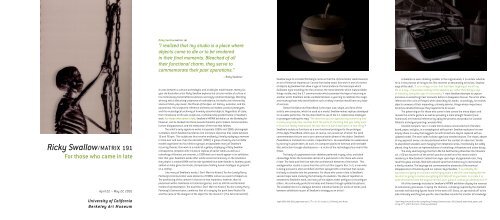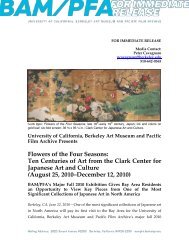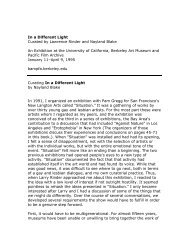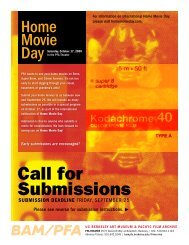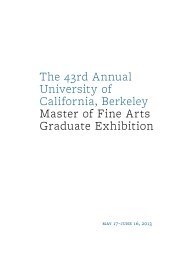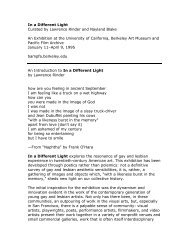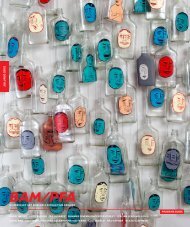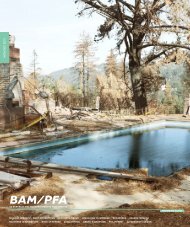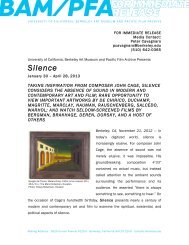Ricky Swallow - Berkeley Art Museum and Pacific Film Archive ...
Ricky Swallow - Berkeley Art Museum and Pacific Film Archive ...
Ricky Swallow - Berkeley Art Museum and Pacific Film Archive ...
You also want an ePaper? Increase the reach of your titles
YUMPU automatically turns print PDFs into web optimized ePapers that Google loves.
<strong>Ricky</strong> <strong>Swallow</strong>/ M AT RIX 191<br />
“I realized that my studio is a place where<br />
objects come to die or to be rendered<br />
in their final moments. Bleached of all<br />
their functional charm, they serve to<br />
commemorate their past operations.”<br />
<strong>Ricky</strong> <strong>Swallow</strong>/MATRIX 191<br />
For those who came in late<br />
April 22 – May 27, 2001<br />
—<strong>Ricky</strong> <strong>Swallow</strong> 1<br />
A cross between a cultural archeologist <strong>and</strong> a hobbyist model maker, twenty-six<br />
year old Australian artist <strong>Ricky</strong> <strong>Swallow</strong> explores the circular motion of culture in<br />
his meticulously h<strong>and</strong>crafted sculptures <strong>and</strong> coyly rendered drawings. Blending<br />
whimsy with a disturbing undertone of malevolence, his works are informed by<br />
science fiction, pop music, the Planet of the Apes, art history, evolution, <strong>and</strong> the<br />
paranormal. His sculptures reference architectural models, product prototypes,<br />
<strong>and</strong> the museological archiving of formerly essential objects. Regardless of scale,<br />
from miniatures to life-size sculptures, craftsmanship predominates in <strong>Swallow</strong>’s<br />
work. For those who came in late, <strong>Swallow</strong>’s MATRIX exhibition at the <strong>Berkeley</strong> <strong>Art</strong><br />
<strong>Museum</strong>, can be divided into three pseudo-thematic parts: broken communication,<br />
human disappearance, <strong>and</strong> the celebration of the time that follows.<br />
The artist’s early signature works incorporate 1950s <strong>and</strong> 1960s phonograph<br />
turntables, which <strong>Swallow</strong> transforms into miniature dioramas that rotate between<br />
16 <strong>and</strong> 78 rpm. The sculptures thus revolve endlessly, literally replaying a moment<br />
in time over <strong>and</strong> over. Even the odd orbit (1999), a group of twenty-one turntable<br />
models organized into four distinct groups, encapsulates many of <strong>Swallow</strong>’s<br />
recurring themes. One work is a model of a gallery displaying a <strong>Ricky</strong> <strong>Swallow</strong><br />
retrospective complete with miniature replicas of earlier works as well as a<br />
rethinking of Humans are smarter, a 1998 work as it would appear in an exhibition<br />
later that year. <strong>Swallow</strong>’s works offer subtle social commentary on the situations<br />
they depict: a crashed BMX <strong>and</strong> its rider sprawled face down beside it; faceless youth<br />
seated at video game terminals; chimpanzees holding human hostages at gunpoint<br />
on a rooftop.<br />
Like many of <strong>Swallow</strong>’s works, I Don’t Want to Know if You Are Lonely/Harry<br />
Feinberg’s Communicator uses elements of 1980s culture as a point of departure.<br />
The positioning of the content in that era is less important, however, than its<br />
placement within traditional art historical genres, such as still life <strong>and</strong> formalist<br />
modes of representation. The dual title, I Don’t Want to Know if You Are Lonely/Harry<br />
Feinberg’s Communicator, combines that of a song by the punk b<strong>and</strong> Husker Dü<br />
<strong>and</strong> the name of the designer of the object for the movie E.T. (The Extra-Terrestrial).<br />
<strong>Swallow</strong> says he included Feinberg’s name so that the communicator would assume<br />
an air of historical importance. Carved from balsa wood, this work is one of a series<br />
of objects by <strong>Swallow</strong> that allow a type of transcendence: the telescope which<br />
facilitates eyes travelling into the universe; the metal detector which makes hidden<br />
things visible; <strong>and</strong>, the E.T. communicator which promises the hope of returning to<br />
another world. <strong>Swallow</strong>’s works vacillate between a yearning to celebrate the magic<br />
<strong>and</strong> mocking those who would believe such a hokey invention would have any hope<br />
of success.<br />
Silence Kit/Upturned PowerBook is the exact size, shape, <strong>and</strong> form of the<br />
artist’s own computer, which he used as a model. <strong>Swallow</strong> makes replicas developed<br />
to unusable perfection. He has described his use of the 1:1 relationship employed<br />
in prototype making this way: “The idea that you are approaching something that<br />
in every way looks like, <strong>and</strong> has all of the parts of, the thing that you really want<br />
it to be, but totally emphasizes the fact that it is just a fabrication of that thing.” 2<br />
<strong>Swallow</strong>’s sculpture functions as a non-functional prototype for the prototype<br />
of the Apple PowerBook, which was, of course, not carved out of wood. The work<br />
commemorates the pre-use or pre-communication phase of the object. <strong>Swallow</strong>’s<br />
PowerBook is mutated into a static, inoperable form. He exacerbates its uselessness<br />
by turning it upside down. As such, his computer posits its eventual <strong>and</strong> inevitable<br />
fate: extinction through obsolescence—-a victim of the technological survival of the<br />
fittest.<br />
The body of a pigmented resin skeleton patterned in gray, olive, <strong>and</strong> black<br />
camouflage forms the horizontal section of a park bench in For those who came<br />
in late. The head <strong>and</strong> feet fuse with the architectural elements of the bench. This<br />
amalgamation recalls a scene from the sci-fi cult film Logan’s Run. In it, a man who<br />
is being pursued is shot <strong>and</strong> killed <strong>and</strong> then sprayed with a chemical that causes<br />
his body to dissolve into the pavement. For those who came in late is <strong>Swallow</strong>’s<br />
second major work involving the full body of a skeleton. The idea of repetition is<br />
essential to <strong>Swallow</strong>’s work, <strong>and</strong> many of his objects either prefigure or reconfigure<br />
others. He continually perfects his ideas <strong>and</strong> themes through updated sculptures.<br />
The establishment of a dialogue between individual works (or series of works) <strong>and</strong><br />
between exhibitions is part of <strong>Swallow</strong>’s strategy as an artist. 3<br />
A skeleton is seen climbing a ladder in the original work; it is unclear whether<br />
he is in the process of rising to his first moment or descending to his last. <strong>Swallow</strong><br />
says of the skull, “It is an image or icon that has been laughing at me all my<br />
life in a way...I have been looking at the skeleton as, rather then being a sign<br />
of mortality, being the sign of immortality.” 4 Here <strong>Swallow</strong> attempts to capture<br />
someone or something’s last moments before it disappears forever. The artist often<br />
references the ruins of Pompeii when describing his works. Accordingly, he records<br />
objects unaware of their impending, untimely demise, things whose importance<br />
becomes elevated because they happened to be saved.<br />
The patterning on For those who came in late covers the entire object <strong>and</strong><br />
reveals the artist’s gesture as well as providing a more straight forward (<strong>and</strong><br />
humorous) art historical reference by aping the process <strong>and</strong> product of Jackson<br />
Pollock’s archetypal painting Lavender Mist.<br />
Vacated Campers, two 1:1 scale tennis shoes constructed out of binders<br />
board, paper, <strong>and</strong> glue, is a metaphysical self-portrait. <strong>Swallow</strong> replicates his own<br />
empty shoes in a way that suggests he will himself one day be replaced with an<br />
updated model. The worn soles indicate aged <strong>and</strong> traveled objects. The shoes, absent<br />
of any apparent owner, can be positioned within the context of urban lore. Similar<br />
to ab<strong>and</strong>oned sneakers seen hanging from telephone wires, intentionally but oddly<br />
placed, they function as representations of vanishing civilizations <strong>and</strong> urban decay.<br />
The sixty skull keyrings that form We the Sedimentary Ones/Use Your Illusions<br />
vol. 1-60 are souvenirs of the artist’s practice as well as of his recent artist’s<br />
residency in New Zeal<strong>and</strong>. Created from layer upon layer of pigmented resin, they<br />
recall the glass animals filled with colored s<strong>and</strong> that children buy to memorialize<br />
a family vacation. The keyrings are commemorative elements of the eventual<br />
disappearance of humanity <strong>and</strong> our culture. Says <strong>Swallow</strong>, “It is probably the<br />
equivalent of going to a concert <strong>and</strong> bringing home a tee-shirt <strong>and</strong> hoping that the<br />
tee-shirt is going to contain everything till it falls off of your back. In a scale it is<br />
quite diminished from the original concert, but I guess it is what you attribute to it.” 5<br />
All of the drawings included in <strong>Swallow</strong>’s MATRIX exhibition display the reversal<br />
of evolutionary processes. In Aping the Humans, a drawing inspired by the dramatic<br />
contrast <strong>and</strong> haunting figures found in the work of El Greco, an ape st<strong>and</strong>s off to the<br />
side intensely watching two youths. Here <strong>Swallow</strong> records the transfer of knowledge<br />
University of California<br />
<strong>Berkeley</strong> Ar t <strong>Museum</strong><br />
Apple 2001 B/W, 2001; pigmented resin; 3 3 /4 x 3 x 3 in. (scale 1:1). Photo by John Brash.<br />
I Don’t Want to Know if You Are Lonely/Harry Feinberg’s Communicator, 2001 (detail); balsa wood, plaster, <strong>and</strong><br />
string; 37 3 /4 x 98 7/16 x 59 in. Photo by John Brash.
that is necessary for the apes to take over the planet once humanity disappears. In<br />
<strong>Swallow</strong>’s world, as in Planet of the Apes, the apes win in the end.<br />
While artists such as Keith Edmier recreate objects of personal importance<br />
from their childhood; Tom Sachs constructs replicas of ordinary objects <strong>and</strong> cultural<br />
icons; Callum Morton explores the concept of the architectural model; <strong>and</strong> Michael<br />
Ashkin fabricates miniature scenes of dystopic events, <strong>Ricky</strong> <strong>Swallow</strong> combines all<br />
of these elements <strong>and</strong> more into his unique <strong>and</strong> arresting art.<br />
In the introductory text for his first solo exhibition in 1997, <strong>Swallow</strong> asked<br />
what would or could be learned from his objects if they were sealed as is in a gallery<br />
excavated in the future. <strong>Swallow</strong> mines culture for content <strong>and</strong> peppers his work<br />
with social commentary. His acutely contemporary objects, resembling nature morte<br />
<strong>and</strong> presenting vanitas, are actually somewhat conservative: representational with<br />
an overt interpretation. Themes of death <strong>and</strong> immortality, evolution <strong>and</strong> survival,<br />
<strong>and</strong> transience <strong>and</strong> permanence filter in <strong>and</strong> out. The most moving <strong>and</strong> poignant<br />
description of <strong>Swallow</strong>’s work that I have read was written by critic Justin Patton:<br />
“Think of the gypsy Melquiades, in the first scene of Gabriel Garcia Marquez’s One<br />
Hundred Years of Solitude, whose magnet pulls a cargo of lost objects out from their<br />
hiding places. His motto might be <strong>Swallow</strong>’s: ‘Things have a life of their own. It’s<br />
simply a matter of waking up their souls.’” 6<br />
Heidi Zuckerman Jacobson<br />
Phyllis Wattis MATRIX Curator<br />
1 Telephone conversation between <strong>Ricky</strong> <strong>Swallow</strong> <strong>and</strong> the author, 3/14/2001.<br />
2 Marah Braye, “The Voyeur Awakes,” <strong>Art</strong> <strong>and</strong> Australia, Winter 2001, vol. 38, no. 4, p. 566.<br />
3 Ibid., p. 565.<br />
4 Lara Travis, “None More Blacker,” None More Blacker (Melbourne, Australia: 200 Gertrude Street,<br />
2001), n/p.<br />
5 Ibid.<br />
6 Justin Paton, “The Recreation Room,” Above Ground Sculpture (Dunedin, New Zeal<strong>and</strong>: Dunedin<br />
Public <strong>Art</strong> Gallery, 2000), n/p.<br />
<strong>Ricky</strong> <strong>Swallow</strong> was born in 1974 in San Remo, Australia. He attended the Victorian College of the<br />
<strong>Art</strong>s in Melbourne, Australia, where he received his Bachelor of Fine <strong>Art</strong>s in 1997. He continues<br />
to live <strong>and</strong> work in Melbourne.<br />
Selected Solo Exhibitions<br />
2000<br />
"Above Ground Sculpture," Dunedin Public <strong>Art</strong> Gallery, Dunedin, New Zeal<strong>and</strong>, <strong>and</strong> Hamish McKay<br />
Gallery, Wellington, New Zeal<strong>and</strong><br />
"Unplugged," Darren Knight Gallery, Sydney, Australia<br />
"Platstruct," Karyn Lovegrove Gallery, Los Angeles, CA<br />
"Individual Ape," Hot Rod Tea Room, Oslo, Norway<br />
1999<br />
"The Multistylus Programme," Studio 12, 200 Gertrude Street Gallery, Melbourne, Australia<br />
1998<br />
"Repo Man," Darren Knight Gallery, Sydney, Australia<br />
1997<br />
"The Lighter Side of the Dark Side," Grey Area <strong>Art</strong> Space Inc., Melbourne, Australia<br />
Selected Group Exhibitions<br />
2001<br />
"<strong>Ricky</strong> <strong>Swallow</strong> <strong>and</strong> Erick Swenson," <strong>Museum</strong> of Contemporary <strong>Art</strong>, Sydney, Australia<br />
"None More Blacker," 200 Gertrude Street Gallery, Melbourne, Australia<br />
"Utopia / ROR," Kiasma <strong>Museum</strong> of Contempoary <strong>Art</strong>, Helsinki, Finl<strong>and</strong><br />
2000<br />
"Keith Edmier, <strong>Ricky</strong> <strong>Swallow</strong>, Erick Swenson," Andrea Rosen Gallery, New York, NY<br />
"Drawn From Life," Marianne Boesky Gallery, New York, NY<br />
"Terra Mirabilis," Centre for Visual <strong>Art</strong>s, Cardiff, Wales<br />
"Br<strong>and</strong> New Master Copy," UKS Gallery, Oslo, Norway<br />
"Rent," Overgaden Gallery, Copenhagen, Denmark<br />
1999<br />
"Contempora5," The Ian Potter <strong>Museum</strong> of <strong>Art</strong>, Melbourne, Australia<br />
"Signs of Life," Melbourne International Biennial, Melbourne, Australia<br />
"Spellbound," Karyn Lovegrove Gallery, Los Angeles, CA<br />
"Walkmen," with David Jolly <strong>and</strong> David Noonan, Synaesthesia Music, Melbourne, Australia<br />
1998<br />
"Institutional Transit Lobby," 200 Gertrude Street Gallery, Melbourne, Australia<br />
"Video Soup," Collective Gallery, Edinburgh, Scotl<strong>and</strong><br />
"Hobby Core," Stripp Gallery, Melbourne, Australia<br />
"All This And Heaven Too," Adelaide Biennial Exhibition, <strong>Art</strong> Gallery of South Australia, Adelaide,<br />
Australia<br />
Selected Catalogues <strong>and</strong> Publications<br />
None More Blacker, 200 Gertrude Street Gallery, Melbourne, Australia, 2001.<br />
<strong>Ricky</strong> <strong>Swallow</strong> / Erick Swenson, <strong>Museum</strong> of Contemporary <strong>Art</strong>, Sydney, Australia, 2001.<br />
All This And Heaven Too, <strong>Art</strong> Gallery of South Australia, Adelaide, Australia, 1998.<br />
Above Ground Sculpture, Dunedin Public <strong>Art</strong> Gallery, Dunedin, New Zeal<strong>and</strong>, 2000.<br />
Br<strong>and</strong> New Master Copy, UKS Gallery, Oslo, Norway, 2000.<br />
Contempora5, Ian Potter <strong>Museum</strong> of <strong>Art</strong>, Melbourne, Australia, 1999.<br />
Memory Made Plastic / <strong>Ricky</strong> <strong>Swallow</strong>, published in collaboration with Darren Knight Gallery,<br />
Sydney, Australia, 1999.<br />
Selected Bibliography<br />
Braye, Marah. "The Voyeur Awakes," <strong>Art</strong> <strong>and</strong> Australia, Winter 2001, vol. 38, no. 4, pp. 560-567.<br />
Engberg, Juliana. "No Radio," <strong>Art</strong>/Text, August–October 1998, no. 62, pp. 32-35.<br />
Nicholson, Tom. "<strong>Ricky</strong> <strong>Swallow</strong>: Leagues Under the Sea," Like, <strong>Art</strong> Magazine, Summer/Autumn<br />
1997/98, no. 5, pp. 12-16.<br />
Palmer, Daniel. "Shadowplay," Frieze, April 2001, no. 58, pp. 84-87.<br />
_____. "Melbourne International Biennial," Frieze, September 1999, no. 48, p. 100.<br />
Work in MATRIX<br />
Apple 2001 B/W, 2001<br />
Pigmented resin<br />
Scale 1:1<br />
3 3 /4 x 3 x 3 in. (9.5 x 7.5 x 7.5 cm)<br />
Courtesy of the artist <strong>and</strong> Darren Knight<br />
Gallery, Sydney<br />
For those who came in late, 2001<br />
Pigmented resin <strong>and</strong> wire<br />
Scale 1:1<br />
31 1 /2 x 59 x 27 1 /2 in. (80 x 150 x 70 cm)<br />
Courtesy of the artist <strong>and</strong> Darren Knight<br />
Gallery, Sydney<br />
I Don’t Want to Know if You Are Lonely/Harry<br />
Feinberg’s Communicator, 2001<br />
Balsa wood, plaster, <strong>and</strong> string<br />
37 3 /4 x 98 7 /16 x 59 in. (95.8 x 250 x 150 cm)<br />
Courtesy of the artist <strong>and</strong> Darren Knight<br />
Gallery, Sydney<br />
Silence Kit/Upturned PowerBook, 2001<br />
Balsa wood, plaster, <strong>and</strong> colored Plexiglas<br />
Scale 1:1<br />
24 x 54 3 /4 x 20 3 /4 in. (61 x 139 x 52 cm)<br />
Courtesy of the artist <strong>and</strong> Darren Knight<br />
Gallery, Sydney<br />
Vacated Campers, 2000<br />
Binders board, paper, <strong>and</strong> glue<br />
Scale 1:1<br />
3 15 /16 x 12 5 /8 x 13 3 /4 in. (10 x 32 x 35 cm)<br />
Private collection, Brisbane<br />
We the Sedimentary Ones/ Use Your Illusions<br />
vol. 1-60, 2000<br />
Pigmented resin, keyrings<br />
60 keyrings, each approximately 2 x 1 3 /8 x<br />
1 3 /8 in. (5 x 3.5 x 3.5 cm); 22 7 /16 x 48 7 /16 x 1<br />
3 /8 in. (57 x 123 x 3.5 cm) overall<br />
Courtesy of Hamish McKay Gallery, Wellington,<br />
New Zeal<strong>and</strong><br />
Aping the Humans, 2001<br />
Watercolor on paper<br />
11 x 15 in. (28 x 38 cm)<br />
Courtesy of the artist <strong>and</strong> Darren Knight<br />
Gallery, Sydney<br />
Communication, 2001<br />
Watercolor on paper<br />
15 x 11 in. (38 x 28 cm)<br />
Courtesy of the artist <strong>and</strong> Darren Knight<br />
Gallery, Sydney<br />
Chain, 2001<br />
Watercolor on paper<br />
15 x 11 in. (38 x 28 cm)<br />
Courtesy of the artist <strong>and</strong> Darren Knight<br />
Gallery, Sydney<br />
Earth Time/Ship Time, 2001<br />
Watercolor on paper<br />
11 x 15 in. (28 x 38 cm)<br />
Courtesy of the artist <strong>and</strong> Darren Knight<br />
Gallery, Sydney<br />
Outdoor Ape, 2001<br />
Watercolor on paper<br />
15 x 11 in. (38 x 28 cm)<br />
Courtesy of the artist <strong>and</strong> Darren Knight<br />
Gallery, Sydney<br />
25 additional works on paper, all 2001:<br />
Watercolor on paper<br />
11 x 15 in. (28 x 38 cm)<br />
Courtesy of the artist <strong>and</strong> Darren Knight<br />
Gallery, Sydney<br />
Please Note:<br />
Heidi Zuckerman Jacobson will give a curator’s walkthrough of this exhibition, along<br />
with Ed Osborn/MATRIX 193 Vanishing Point, on Thursday, May 3, at 12:15 p.m.<br />
The MATRIX Program at the UC <strong>Berkeley</strong> <strong>Art</strong> <strong>Museum</strong> is made possible by the generous endowment<br />
gift of Phyllis Wattis.<br />
Additional donors to the MATRIX Program include the UAM MATRIX Council Endowment, Ann M. Hatch,<br />
Eric McDougall, <strong>and</strong> the California <strong>Art</strong>s Council.<br />
<strong>Ricky</strong> <strong>Swallow</strong>/MATRIX 191 For those who came in late has been assisted by the Commonwealth<br />
Government through the Australia Council, its arts funding <strong>and</strong> advisory body.<br />
<strong>Ricky</strong> <strong>Swallow</strong> acknowledges the support of the following people: Kati Jane Rule, Chad Chatterton,<br />
Fiona Abicare, Nick Johns, Damiano Bertoli, Andy Alex<strong>and</strong>er, Darren Knight, Hamish McKay, Karyn<br />
Lovegrove, Justin Paton, Mike Conole, Yani Florence, Chris Gregory, <strong>and</strong> John Brash.<br />
© 2001 The Regents of the University of California. All Rights Reserved.<br />
Vacated Campers, 2000; binders board, paper, <strong>and</strong> glue; 3 15 /16 x 12 5 /8 x 13 3 /4 in. (scale 1:1). Photo by Paul Green.<br />
We the Sedimentary Ones/Use Your Illusions vol. 1-60, 2000; pigmented resin, keyrings; 60 keyrings,<br />
approximately 22 7 /16 x 48 7 /16 x 1 3 /8 in. overall. Photo by Bill Nichol.<br />
Communication, 2001 (detail); watercolor on paper; 15 x 11 in. Photo by John Brash.<br />
COVER: The First One Now, 2000; pigmented resin; 25 x 23 x 50 in. (scale 1:1). Photo by Paul Green.<br />
ABOVE: Even the Odd Orbit, 1998-99; portable turntables, chip M.D.F., printed figures, acrylic paint; dimensions variable;<br />
"Signs of Life," Melbourne International Biennial, Melbourne, Australia—installation view. Photo by Kenneth Pleban.


